|
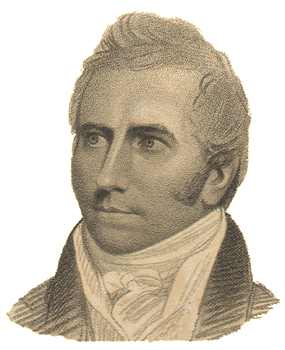
Lord Amherst
Frontispiece Portrait
~~ Journal of the Proceedings of the Late Embassy
to China, Comprising a Correct Narrative of the Public
Transactions of the Embassy, of the Voyage to and From China ~~
by Henry Ellis, 1817
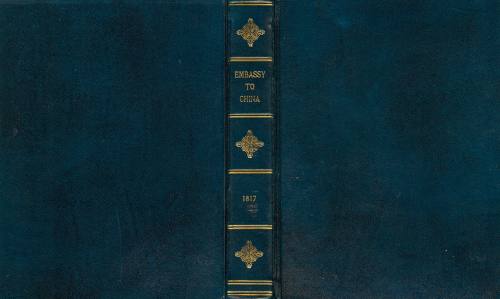
(Modern Rebinding)
Ellis, Henry (Third Commissioner of the Embassy):
Journal of the Proceedings of the Late Embassy to China, Comprising a Correct Narrative of the Public Transactions of the Embassy, of the Voyage to and From China, and of the Journey From the Mouth of the Pei-Ho to the Return to Canton. Interspersed with Observations Upon the Face of the Country, the Policy, Moral Character, and Manners of the Chinese Nation. The Whole Illustrated by Maps and Drawings., London, Printed for John Murray by "T. Davison, Lombard-street, Whitefriars, London," 1817, 4to, black and white tissue guard protected stipple engraved frontispiece with portrait of Lord Amherst, 7 hand colored tissue guard protected aquatint plates engraved by J. Clark from drawings by Charles Abbott, 3 copper engraved maps (one being a large folding map - 42 x 53 cm), 13 appendices, iv, 526 pp.
This British embassy was recommended to the King of England by the Directors of the East India Company based upon interference with their trade by the Viceroy of Canton. The East India Company actually financed the embassy and it was in the interests of that agency that the embassy was dispatched. A request directly to the Emperor of China for a redress of grievances was the key mission of the embassy. The Amherst embassy to China departed England on February 8, 1816 aboard H.M.S. Alceste commanded Captain Maxwell and H.M. Brig Lyra commanded by Captain Basil Hall. The embassy arrived in China in early August.
Lord Amherst traveled inland arriving at Yuen-Ming-Yuen (Pekin) on August 29, 1816 for an audience with the Emperor. To his consternation, the Emperor demanded to see him immediately on his arrival. Lord Amherst declined based upon ill health and the desire to recover from the overland journey. The British believed that the Emperor wanted to see Amherst privately to insist that he perform the "ko-tou" ceremony of prostration during the public reception of the embassy. The Emperor immediately ordered the embassy to depart and this was done the next day. Amherst never did see the Emperor to request the redress of grievances, the main objective of the mission. After the fact, it appears the Emperor planned on making Lord Amherst perform an elaborate series prostrations during the official reception.
Despite being dismissed by the Emperor, Amherst traveled extensively throughout China and did not depart until January of 1817. He dispatched H.M.S. Alceste and H.M Brig Lyra on surveying expeditions commanded by Captain Maxwell to Korea and Okinawa (Loochoo) in late August of 1816. This aspect of the mission is covered rather briefly ("Remarks upon Corea and Loo-Choo Islands") in Chapter IX (pages 469-491). The ships spent considerable time in Okinawa (September 16 to 28 October). This aspect of the expedition was covered in great detail in important books written by John McLeod and Basil Hall and published at the same time as this book (see below). Both McLeod and Hall were members of the embassy. The embassy departed China on January 21, 1817.
During the voyage back to England on February 18 in the Straits of Gaspar in the Java sea near the island of Pulo Leat, H.M.S. Alceste struck a submerged rock and sank. There was no loss of life and Lord Amherst was taken to Batavia aboard the H.M. Brig Lyra. The last aquatint plate shows, in the background, H.M.S. Alceste on fire and sinking. On the return voyage Lord Amherst visited with Napoleon Bonaparte who was in exile on St. Helena. The mission was completed at Spithead on August 17, 1817.
This embassy was extensively documented in non-government books published shortly after it was completed. In fact, this seemed to have been an officially sanctioned policy of the British Government. The following quote is found at the foot of the title page:
It is a strange thing, that in sea voyages, where there is nothing to be seen but sky and sea, men should make diaries; but in land travel, wherein so much is to be observed, for the most part they omit it; as if chance were fitter to be registered than observation; let diaries therefore be brought in use. Lord Bacon
The strategic and ultimate mission of the embassy was not accomplished. Lord Amherst was denied the personal audience with the Emperor of China to present the British grievances. On a tactical level, while the mission went rather smoothly, the embassy suffered a catastrophe in the sinking of the lead ship, H.M. Ship Alceste. In addition, H.M. Brig Lyra was nearly shipwrecked on the coral reefs as she surveyed Okinawa. Despite the major failures, the embassy performed an important role in acquainting the general public with the conditions in China and the then relatively unknown of Kingdoms of Korea and Loo-Choo.
Major Accounts Published Regarding the Amherst Embassy:
Henry Ellis, 1817, Journal of the Proceedings of the Late Embassy to China; Comprising a Correct Narrative of the Public Transactions of the Embassy, of the Voyage to and from China, and of the Journey from the Mouth of the Pei-Ho to the Return to Canton, Interspersed with Observations upon the Face of the Country, the Polity, Moral Character, and Manners of the Chinese Nation, Illustrated by Maps and Drawings, London. Information here.
John McLeod, 1817, Narrative of a Voyage, in His Majesty's Late Ship Alceste, to the Yellow Sea, Along the Coast of Corea and Through its Numerous Hitherto Undiscovered Islands, to the Island of Lewchew; with an Account of Her Shipwreck in the Straits of Gaspar, London. Information here.
Clarke Abel, 1818, Narrative of a Journey in the Interior of China, and of a Voyage to and From That Country in the Years 1816 and 1817; containing an Account of the Most interesting Transactions of Lord Amherst's Embassy to the Court of Peking and Observations on the Countries which it Visited, London. Information here.
Basil Hall, 1818, Account of a Voyage of Discovery to the West Coast of Corea and the Great Loo-choo Island; with an Appendix Containing Charts, and Various Hydrographical and Scientific Notices. By Captain Basil Hall, Royal Navy, F.R.S. Lond. & Edin. Member of the Asiatic Society of Calcutta, of the Literary Society of Bombay, and of the Society of Arts and Sciences of Batavia. And a Vocabulary of the Loo-Choo Language, by H. J. Clifford, Esq., Lieutenant, Royal Navy, London. here.
Title Page:
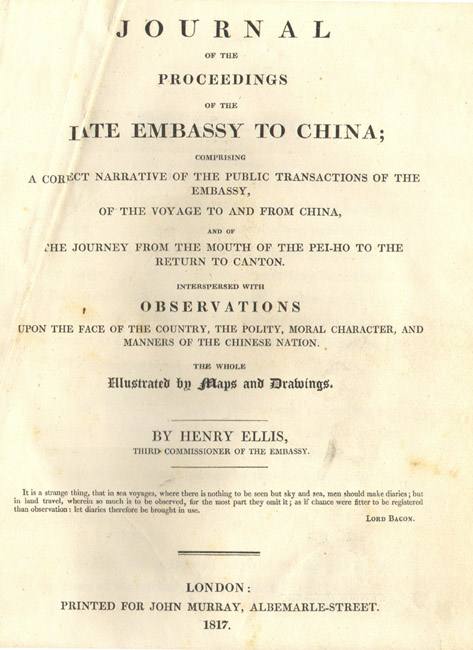
Frontispiece
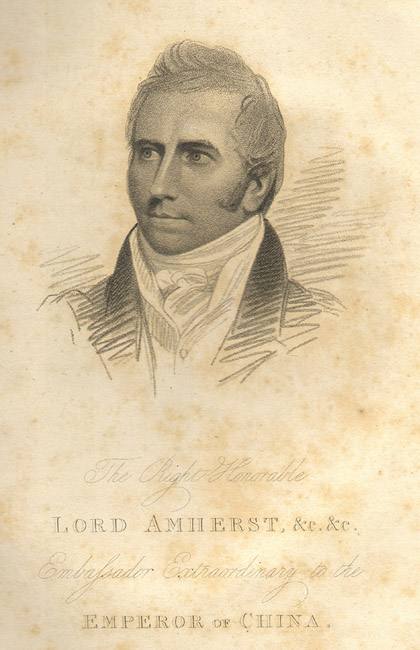
The Right Honorable Lord Amherst &c. &c.
Embasador Extraordinary to the Emperor of China.
Illustrations (7 hand-colored aquatint plates)
Summer Palace of the Emperor, opposite the City of Tien-sing. (facing page 90)
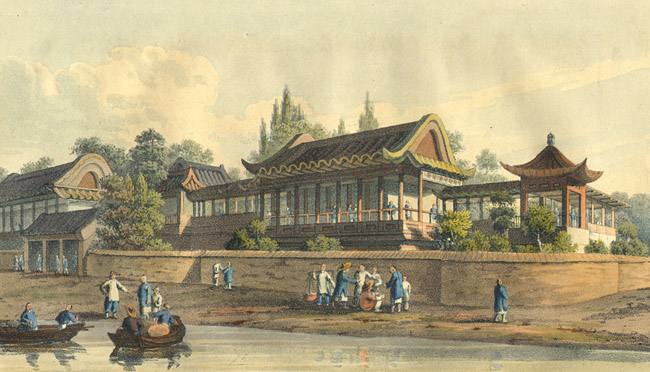 Anchorage at Tong-Chow. (facing page 138)
Anchorage at Tong-Chow. (facing page 138)
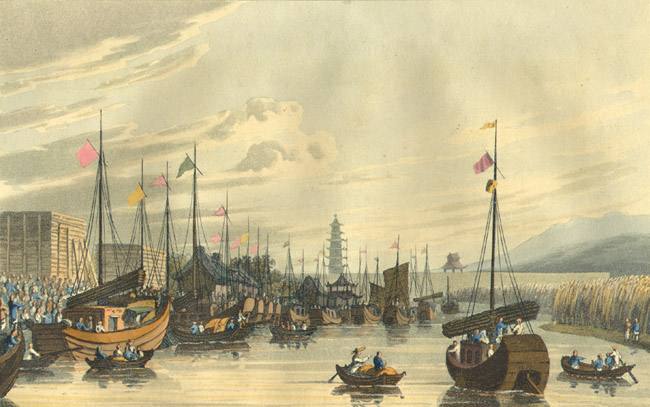 Temple of Quan-Yin-Mun, near Nankin (facing page 296)
Temple of Quan-Yin-Mun, near Nankin (facing page 296)
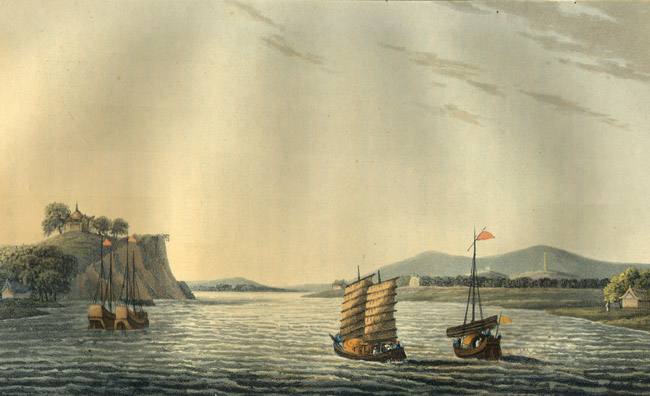 See-Lang-Shin (facing page 312)
See-Lang-Shin (facing page 312)
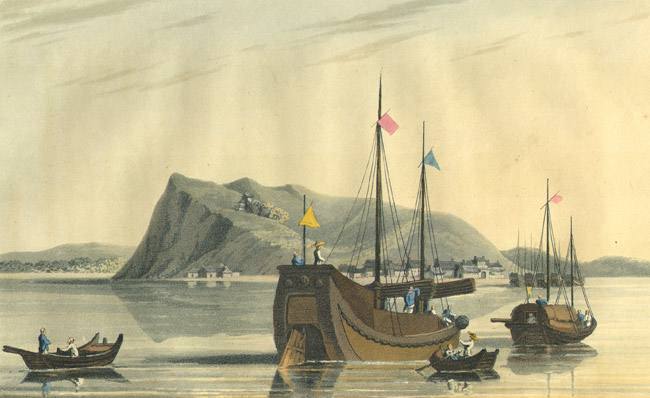 Gan-Kin-Foo, from the West (facing page 328)
Gan-Kin-Foo, from the West (facing page 328)
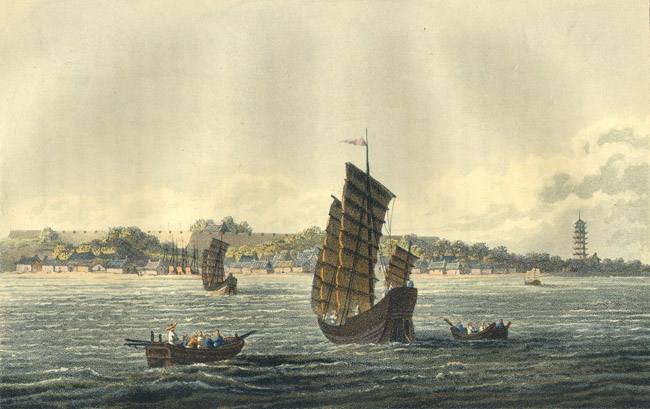 Seaou-Koo-Shan, from the East (facing page 331)
Seaou-Koo-Shan, from the East (facing page 331)
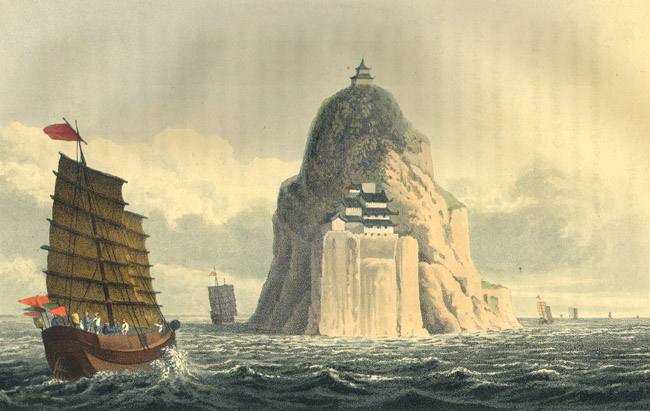 View, Island of Pulo Leat (facing page 455)
View, Island of Pulo Leat (facing page 455)
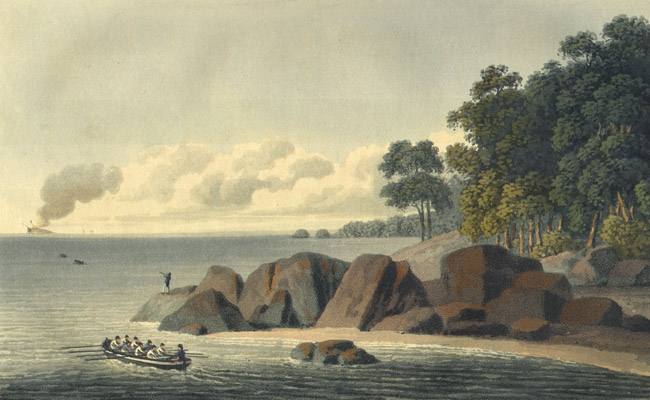 Legends on acquatint plates
Left side below image - "Delt." [Drawn] by "Hon. Charles Abbot"
Legends on acquatint plates
Left side below image - "Delt." [Drawn] by "Hon. Charles Abbot"
 Right side below image - "Sculp" [Carved/Engraved] by "I.(J.) Clark"
Below Descriptive Title
Right side below image - "Sculp" [Carved/Engraved] by "I.(J.) Clark"
Below Descriptive Title
 "London, Published by J. Murray, Albemarle Street. 1817"
Close-up of Aquatint Plate
Summer Palace of the Emperor, opposite the City of Tien-sing. (facing page 90)
"London, Published by J. Murray, Albemarle Street. 1817"
Close-up of Aquatint Plate
Summer Palace of the Emperor, opposite the City of Tien-sing. (facing page 90)
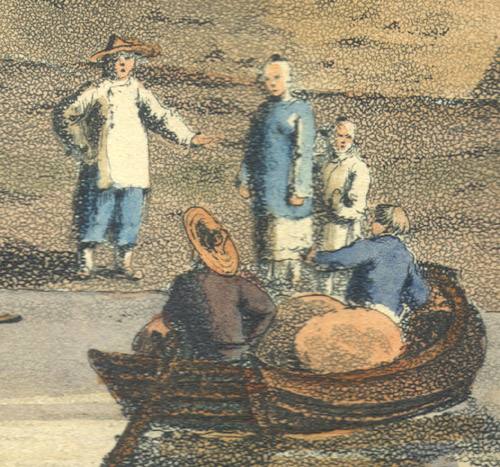 Maps
Map #1 (facing Page 1 opens up and to the left -
When opened out, the map is inverted in relation to the printed text in the book).
Map of the Route of the British Embassy from the Mouth of the Peiho River to Pekin
and from thence to Canton in the Year 1816
Maps
Map #1 (facing Page 1 opens up and to the left -
When opened out, the map is inverted in relation to the printed text in the book).
Map of the Route of the British Embassy from the Mouth of the Peiho River to Pekin
and from thence to Canton in the Year 1816
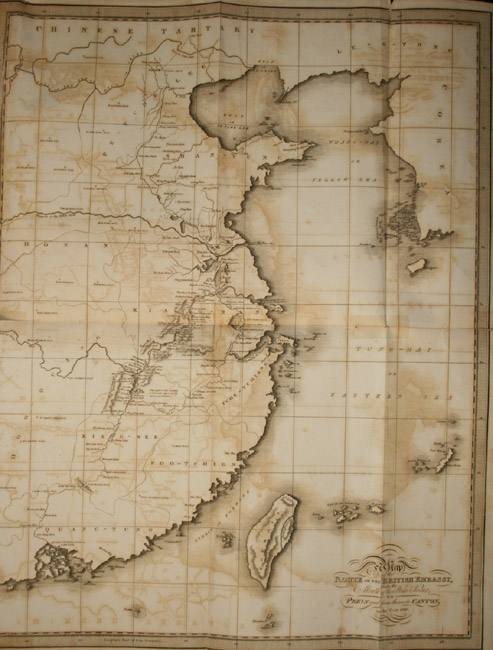 Three folds out, one fold up - 16 1/2 x 21 in 42 x 53 cm
Map #2 (facing Page 292 single sheet)
Map of the Route of the British Embassy Upon the River Yang-Tse-Kiang, from Kwa-Choo
to Nan-Chang-Foo, Drawn by the Hon. Charles Abott.
Three folds out, one fold up - 16 1/2 x 21 in 42 x 53 cm
Map #2 (facing Page 292 single sheet)
Map of the Route of the British Embassy Upon the River Yang-Tse-Kiang, from Kwa-Choo
to Nan-Chang-Foo, Drawn by the Hon. Charles Abott.
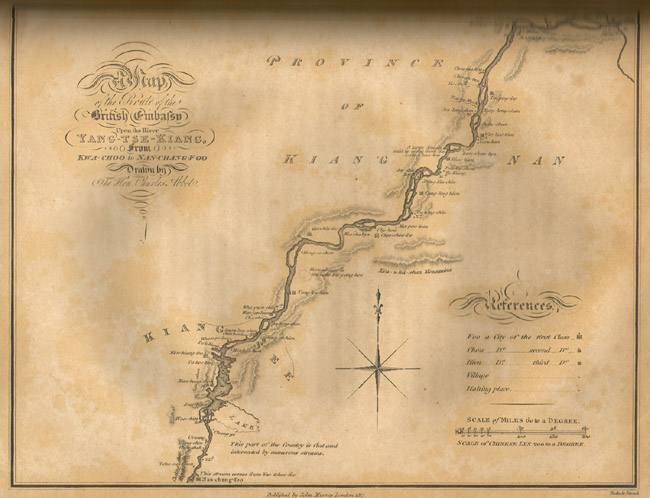 Map #3 (facing Page 450 single sheet)
Track of the Barge & Cutter belonging to His Magestys late Ship Alceste, with
His Excellency The Right Hon. Lord Amherste & Suite on Board From the Wreck to
Batavia, Mr. John R. Mayne, Master of the Alceste, 1817.
Map #3 (facing Page 450 single sheet)
Track of the Barge & Cutter belonging to His Magestys late Ship Alceste, with
His Excellency The Right Hon. Lord Amherste & Suite on Board From the Wreck to
Batavia, Mr. John R. Mayne, Master of the Alceste, 1817.
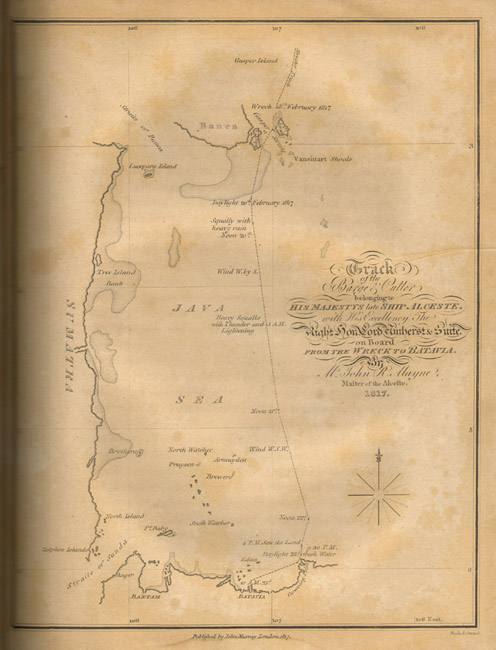 Close-ups
Close up of Loo-Choo Islands from Map #1
Close-ups
Close up of Loo-Choo Islands from Map #1
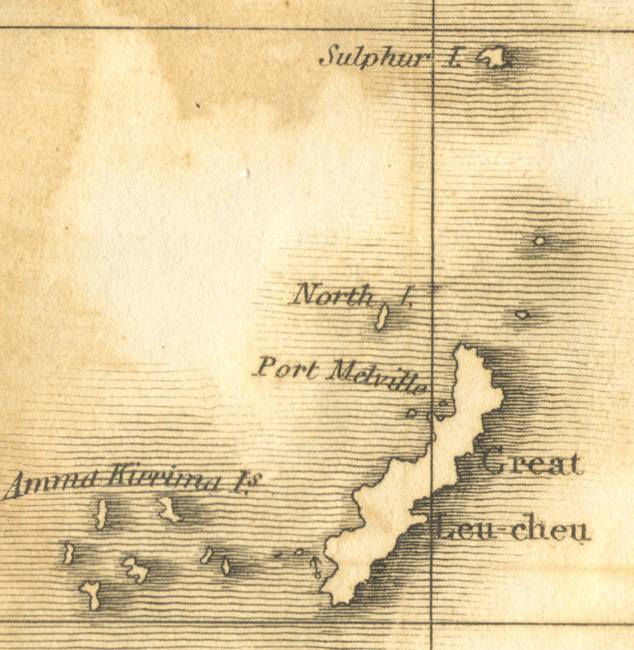 The map shows "Port Melville." For more information on Port Melville,
as it was called by the British, see the note below.
Close up of Plate 7 (View, Island of Pulo Leat)
showing the Sinking of the Alceste
The map shows "Port Melville." For more information on Port Melville,
as it was called by the British, see the note below.
Close up of Plate 7 (View, Island of Pulo Leat)
showing the Sinking of the Alceste

Appendices (13 total, Nos. 1-4, 4a, 6-13)
- No. 1. Address of the Select Committee to the Foo-yuen, announcing the Embassy, dated May 28, 1816. (pages 493-4)
- No. 2. Address of the Select Committee to the foo-yuen, announcing Sir George Staunton's Departure from Macao, dated July 1816. (pages 494-5)
- No. 3. Translation of the Emperor of China's Reply to the Report made to Court by the Viceroy of Canton, respecting the Embassy from his Royal Highness the Price Regent. Received unofficially, July 12th, 1816. (pages 495-496)
- No. 4A. Letter addressed by his Excellency Lord Amherst, to the Emperor of China, dated August 1816. (pages 496-7)
- No. 4. Translation of an Official Document received from Chang-ta-jin on the 26th of August, 1816. (pages 497-9)
- No. 5. Ceremonies to be observed at the Audience of Leave. (pages 499-500).
- No. 6. Extract from the Pekin Gazette of the 13th Day of the 7th Moon of the 21st of Kea-king, September 4, 1816. (pages 501-2)
- No. 7. None
- No. 8. Translation of an Imperial Edict addressed to the Viceroy of Kiang-nan, respecting Treatment of Embassy, received October 8, 1816. (page 502-4)
- No. 9. Translation of a Paper issued in the form of a Proclamation, addressed to native Chinese at Ta-tung, in the Province of Gan-kwuy, respecting the British Embassy, dated 5th Nov. 1816. (pages 504-5)
- No. 10. Translation of an Imperial Edict, dated 15th Day of the 7th Moon of the 21st Year (6th Sept. 1816) of Kea-King, addressed to the Viceroy Tsiang and Foo-yuen Tung of Canton, received the 5th of the 8th Moon (25th Sept.). (pages 505-6)
- No. 11. Paper respecting the Embassy, drawn up by the Emperor. (pages 506-8)
- No. 12. Substance of Imperial Edicts inflicting Punishments on Soo, Ho, and Kwang. (page 509)
- No. 13. Duke Ho's Report from Tong-chow. (page 509-10)
Itinerary (pages 511-514). Begins on Aug 9, 1816 at "Tung-ko, (right bank), entered the Pei-ho and ends on Jan 1, 1817 at Canton.
Index (pages 515-526). References to "Loo-choo Islands" at page 472 and a "Its connection with China--A short account of" at page 477.
Errata. Last page, after page 526.
Back of Errata sheet reads "T. Davison, Lombard-street, Whitefriars, London."
Note on Port Melville, Loo-Choo.
In 1849 Aron Haight published a letter urging the opening of Japan by the United States. He offered the following comment on Port Melville:
Port Melville, called by the natives Outing or Vouching, situated on a bay of the same name, on the western coast of Great Loo Choo, is a safer port than Napakiang (Naha), and capable of receiving ships of the largest size. The bay is two miles in extent, protected from all winds, and affords peculiar advantages and facilities for careening and refitting vessels, so much wanted in those seas. At its entrance is a high conical mountain, called by the natives Egouchkotind, or "the Castle," a prominent land mark, visible 25 miles at sea. (Palmer, Letter of 1849.)
A map of Okinawa included in the official Government narrative of the Perry Expedition to Japan (1853-4) included Port Melville. To see that map, click here.
In 1895 Basil Hall Chamberlain noted the following regarding Port Melville:
The best harbour in Great Luchu is Unten (Port Melville of the British charts), on the north-west coast; but it is, so to say, wasted, because situated in a hilly district remote from the centres of population and trade. For this reason the Japanese steamers and most junks repair to Nafa (or Naha or Naba, as the Japanese sometimes pronounce it, in Shimajiri, near the southern extremity of the island, which is much less good, the inner harbour being only accessible at high tide. Close to Nafa, and indeed practically forming one with it, are the towns of Tomari and Kume-mura. Shuri, the capital (called Shui by modern Luchuans, who habitually drop the r in the middle of words, crowns a hill some 400 feet high standing a little over three miles inland from Nafa. (Geographical Journal, London, The Royal Geographical Society, Volume V, January - June, 1895, article by Basil Hall Chamberlain, at page 294).
Unten is located on the north western side of the Motobu peninsula in the vicinity of Nakijin and Yagai Island.
|











 Right side below image - "Sculp" [Carved/Engraved] by "I.(J.) Clark"
Below Descriptive Title
Right side below image - "Sculp" [Carved/Engraved] by "I.(J.) Clark"
Below Descriptive Title
 "London, Published by J. Murray, Albemarle Street. 1817"
Close-up of Aquatint Plate
Summer Palace of the Emperor, opposite the City of Tien-sing. (facing page 90)
"London, Published by J. Murray, Albemarle Street. 1817"
Close-up of Aquatint Plate
Summer Palace of the Emperor, opposite the City of Tien-sing. (facing page 90)





